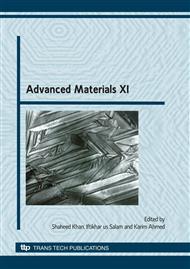p.15
p.26
p.34
p.41
p.52
p.59
p.66
p.74
p.81
Effect of Heat Sinks on Visco-Elastic & Mechanical Properties of EPDM Based Ablative Composites
Abstract:
Ablative composites are heat shielding, protective materials that are being used in aerospace industry to protect inner hardware and sensitive devices. The aero dynamic vehicles have to face high stresses, ultra high temperature and adverse conditions of air friction. It is required to develop the materials with light weight and high modulus. EPDM, being heat and ozone attack resistant is the best candidate for the preparation of ablative composites by introducing different heat sinks such as silica, glass fiber, carbon fiber, asbestos, carbon and their combinations have been studied in this work. The prepared materials were tested and it was found that visco elastic behavior of the composites affected by the addition of reinforcing filler (carbon, silica), semi-reinforcing filler (carbon fiber, glass fiber) and non-reinforcing filler (asbestos powder). Mechanical properties tested at different rates, revealed the improvement in tensile strength and % elongation in case of reinforcing and semi-reinforcing fillers but showed adverse effect in case of non-reinforcing fillers. Rheological investigations of these novel composites shows that moony viscosity of the materials containing glass fiber, carbon fiber, silica decreases in the order glass fiber > carbon fiber > silica.
Info:
Periodical:
Pages:
52-58
Citation:
Online since:
June 2010
Authors:
Keywords:
Price:
Сopyright:
© 2010 Trans Tech Publications Ltd. All Rights Reserved
Share:
Citation:


